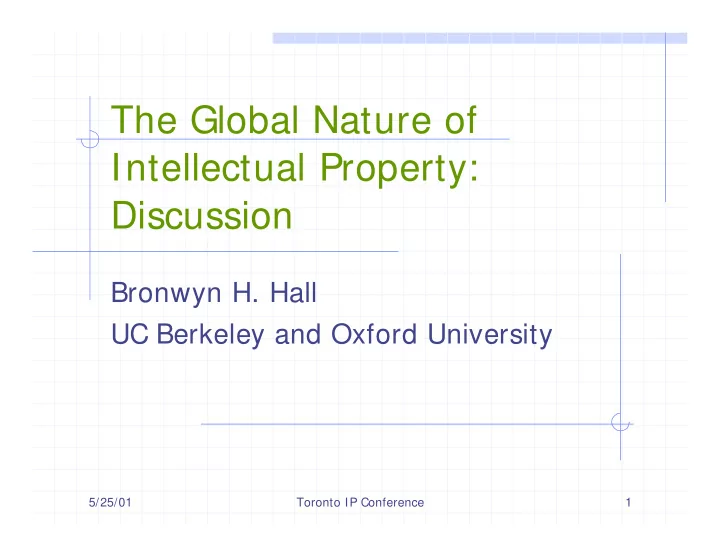

The Global Nature of Intellectual Property: Discussion Bronwyn H. Hall UC Berkeley and Oxford University 5/25/01 Toronto IP Conference 1
Maskus conclusions No reason to shift to “first to invent” Patent term for inventions in medicine and biotechnology – allow for regulatory delay Do not shift toward recognition of broad claims Do not shift to US standard on “burden of proof” in re-exam and litigation Special patent court, but with a slightly different weight Competition-based approach to regulating the exercise of patent rights 5/25/01 Toronto IP Conference 2
The Issues The political economy problem The harmonization problem Some information about the European post-grant opposition process 5/25/01 Toronto IP Conference 3
Political economy of IP IP laws are mostly national Competition and innovation are global Strengthening IP protection (somewhat) like tax competition: � Net benefit for one country, but � Lower social welfare if all countries adopt stronger IP Substantial asymmetries across countries, due to market size and the degree of spillover (language, trade and FDI) The “game” probably has “prisoner’s dilemma” type characteristics 5/25/01 Toronto IP Conference 4
Benefits of stronger IP protection in one country National � Incentives for innovators = > more local R&D � Increases potential local spillovers from R&D International (externality) � Increases global incentives for innovation (larger for larger developed economies) � To be kept in mind: actual outcomes depend strongly on relative costs and productivity – limits free movement of R&D. 5/25/01 Toronto IP Conference 5
Costs of stronger IP protection in one country National � Higher prices due to monopoly power � Raises the cost of follow-on innovation = > may reduce local R&D via increasing transaction costs – this effect can be large in cumulative technologies (see Hall and Ziedonis 2001) International (externality) � Relative incentive for innovation reduced elsewhere (effect larger if country is a larger developed economy) � Cost of follow-on innovation by those in other countries increased (effect larger if country is a larger developed economy) 5/25/01 Toronto IP Conference 6
Harmonization Difficult to achieve � Problems of the community patent (failure in March at Stockholm) in spite of near-universal demand by European business � Involves extensive change to national systems (e.g., litigation harmonization across legal systems with differing origins) � Spain and Portugal – “their languages and national traditions are being overlooked.” � “Each year, the EU corporate sector pays the US $8B in patent royalties while the US pays the EU only $3B.” Tends to increase rather than reduce protection, due to stakeholder lobbying and the difficulties of taking rents away from voters � TRIPS, pharmaceuticals, and less developed countries � European database directive and U.S. measures 5/25/01 Toronto IP Conference 7
Controversies over stronger IP protection Subject matter Inventive step (non-obviousness) Prior art Broad claims (and the quality of description in the patent – is it enough information for someone skilled in the art to do it) The last 3 might be addressed by post-grant re- examination or opposition. 5/25/01 Toronto IP Conference 8
Post-grant challenges: US vs EU United States patent challenges � Reexamination post-issue (life of patent) � Litigation for validity or infringement EU (EPO) patent challenges � Post-grant opposition (within 9 mos.) � Litigation for validity or infringement in national courts 5/25/01 Toronto IP Conference 9
United States (USPTO) Secrecy throughout the period that patent application is pending (until this year, now 18 months) Re-examination after issue – limited to validity questions; examiners are final arbiters. � Administrative ex parte proceeding—requester role limited to application, and to � Right to receive notice of decision � Right to receive copy of patentee’s response � Right to file rejoinder to that response � Relatively large filing fee ($2,500) � Admissible evidence limited—prior patents and publications � Regulatory hurdle: “Substantial question of patentability” � Barrier to pursuing litigation ex post Lesson: significant limitations and not used much 5/25/01 Toronto IP Conference 10
European Patent Office (EPO) Publication of application 18 months after application date Opposition – validity only � Administrative adversarial proceeding initiated by any third party � Time limit: Must file within 9 months of patent grant � Patent may be challenged on any of the grounds of patentability—novelty, inventive step, industrial application � No limits on the kinds of evidence admissible � Examiners and then administrative judges (on appeal) hear challenge � Much lower cost than litigation, but slow. 5/25/01 Toronto IP Conference 11
Institutional Differences: Outcomes Europe � Probability of opposition: 4 to 8% � Opposition lag after application: � median 5.5 years � 90% by 7.5 years � Opposition results � 33% of patents are revoked in full (Merges, 1999) � Our (GHHM) pharma/biotech data confirm these � 25% of patents are confirmed in full � 40% of patents are amended � 34% of patents are revoked in full 5/25/01 Toronto IP Conference 12
Institutional Differences: Outcomes United States � Probability of re-examination: 0.2% � Re-examination lag after application: � median 3.5 years � 90% by 11.5 years � Re-examination results � Stacy 1997 � 28% of patents are confirmed in full � 59% of patents are amended � 13% of patents are revoked in full � GHHM 1980-1999 � 33% of patents are confirmed in full � 46% of patents are amended � 21% of patents only have claims cancelled 5/25/01 Toronto IP Conference 13
Conclusions (besides those already stated) Need a model of the interaction of IP regimes in different jurisdictions Keep an eye on the U.S. � backlash to subject matter expansion and prior art problems (double exams for business method patents) Difficult to put the genie back in the bottle, so go slow on stronger rights 5/25/01 Toronto IP Conference 14
Recommend
More recommend